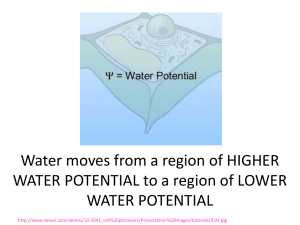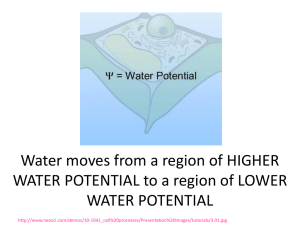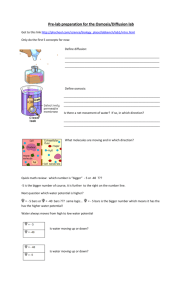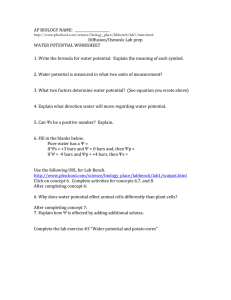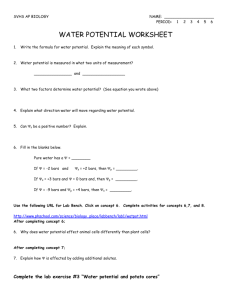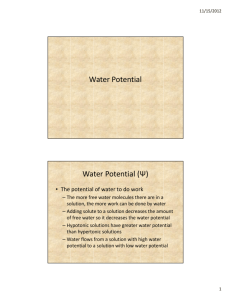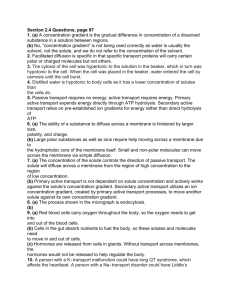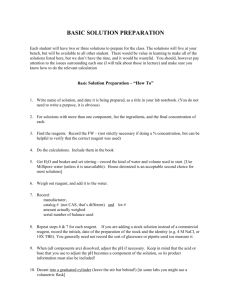Lab Bench: Osmosis & Diffusion
advertisement
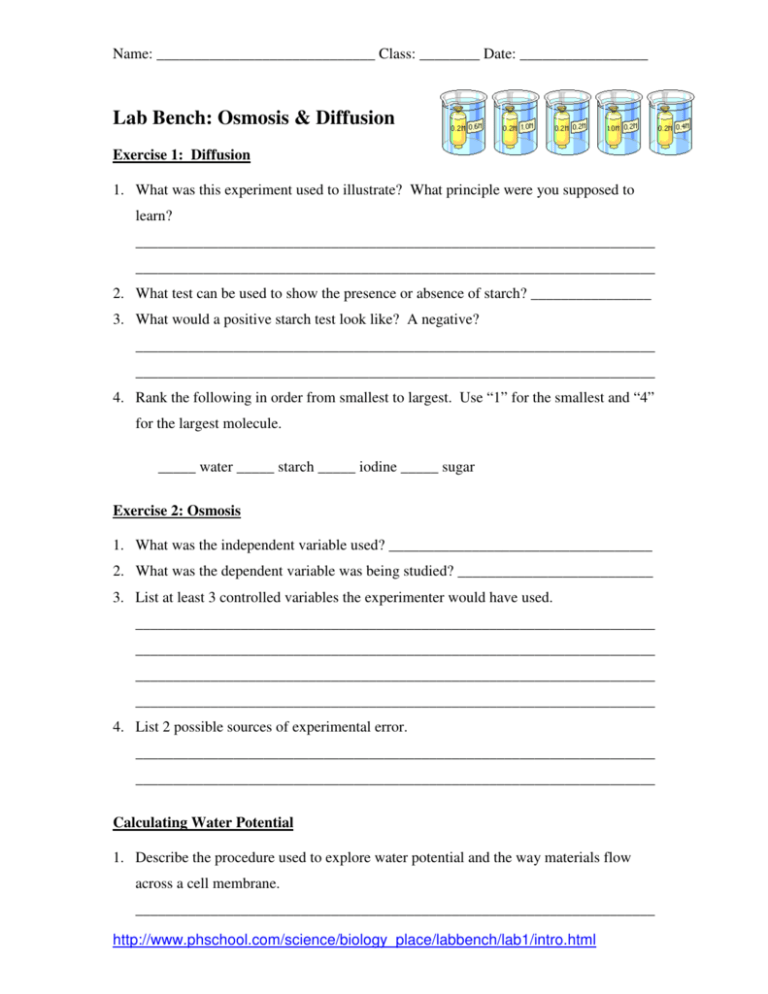
Name: _____________________________ Class: ________ Date: _________________ Lab Bench: Osmosis & Diffusion Exercise 1: Diffusion 1. What was this experiment used to illustrate? What principle were you supposed to learn? _____________________________________________________________________ _____________________________________________________________________ 2. What test can be used to show the presence or absence of starch? ________________ 3. What would a positive starch test look like? A negative? _____________________________________________________________________ _____________________________________________________________________ 4. Rank the following in order from smallest to largest. Use “1” for the smallest and “4” for the largest molecule. _____ water _____ starch _____ iodine _____ sugar Exercise 2: Osmosis 1. What was the independent variable used? ___________________________________ 2. What was the dependent variable was being studied? __________________________ 3. List at least 3 controlled variables the experimenter would have used. _____________________________________________________________________ _____________________________________________________________________ _____________________________________________________________________ _____________________________________________________________________ 4. List 2 possible sources of experimental error. _____________________________________________________________________ _____________________________________________________________________ Calculating Water Potential 1. Describe the procedure used to explore water potential and the way materials flow across a cell membrane. _____________________________________________________________________ http://www.phschool.com/science/biology_place/labbench/lab1/intro.html Name: _____________________________ Class: ________ Date: _________________ _____________________________________________________________________ _____________________________________________________________________ _____________________________________________________________________ _____________________________________________________________________ _____________________________________________________________________ _____________________________________________________________________ _____________________________________________________________________ _____________________________________________________________________ _____________________________________________________________________ _____________________________________________________________________ _____________________________________________________________________ _____________________________________________________________________ _____________________________________________________________________ _____________________________________________________________________ _____________________________________________________________________ _____________________________________________________________________ _____________________________________________________________________ _____________________________________________________________________ _____________________________________________________________________ _____________________________________________________________________ _____________________________________________________________________ _____________________________________________________________________ _____________________________________________________________________ _____________________________________________________________________ _____________________________________________________________________ _____________________________________________________________________ _____________________________________________________________________ _____________________________________________________________________ _____________________________________________________________________ _____________________________________________________________________ _____________________________________________________________________ http://www.phschool.com/science/biology_place/labbench/lab1/intro.html Name: _____________________________ Class: ________ Date: _________________ Water potential is calculated using the following formula: Water potential ( ) = pressure potential ( ) + solute potential ( ) Pressure potential ( ): In a plant cell, pressure exerted by the rigid cell wall that limits further water uptake. Solute potential ( ): The effect of solute concentration. Pure water at atmospheric pressure has a solute potential of zero. As solute is added, the value for solute potential becomes more negative. This causes water potential to decrease also. In sum, as solute is added, the water potential of a solution drops, and water will tend to move into the solution. In this laboratory we use bars as the unit of measure for water potential; 1 bar = approximately 1 atmosphere. 2. There are two components to water potential: solute concentration and pressure. How do you think this fact affects the movement of water into and out of cells? For example, can two solutions that differ in their solute concentration be at equilibrium in terms of water movement? _____________________________________________________________________ _____________________________________________________________________ _____________________________________________________________________ _____________________________________________________________________ 3. Can a solution with a molarity of 0.2 be in equilibrium with a solution with a molarity of 0.4? _____________________________________________________________________ _____________________________________________________________________ _____________________________________________________________________ _____________________________________________________________________ http://www.phschool.com/science/biology_place/labbench/lab1/intro.html Name: _____________________________ Class: ________ Date: _________________ Solute potential ( ) = –iCRT i= The number of particles the molecule will make in water; for NaCl this would be 2; for sucrose or glucose, this number is 1 C= Molar concentration (from your experimental data) R= Pressure constant = 0.0831 liter bar/mole K T= Temperature in degrees Kelvin = 273 + °C of solution Sample Problem 1. Will there be a net movement of water between two isotonic solutions? Why or why not? _____________________________________________________________________ _____________________________________________________________________ 2. Why don't red blood cells pop in the bloodstream? _____________________________________________________________________ _____________________________________________________________________ 3. What will happen if a plant cell is placed in distilled water? _____________________________________________________________________ _____________________________________________________________________ _____________________________________________________________________ _____________________________________________________________________ 4. The molar concentration of a sugar solution in an open beaker has been determined to be 0.3M. Calculate the solute potential at 27 degrees. Round your answer to the nearest hundredth. Show your work! ________________________________________________________________________ ________________________________________________________________________ http://www.phschool.com/science/biology_place/labbench/lab1/intro.html Name: _____________________________ Class: ________ Date: _________________ 5. The pressure potential of a solution open to the air is zero. Since you know the solute potential of the solution, you can now calculate the water potential. (If you need to, review the equation for calculating water potential.) What is the water potential for this example? Round your answer to the nearest hundredth. You’re your work!!! _____________________________________________________________________ _____________________________________________________________________ Lab Quiz 1. Which beaker(s) contain(s) a solution that is hypertonic to the bag? 2. Which bag would you predict to show the least change in mass at the end of the experiment? 3. Arrange the beakers in order of the mass of the bags inside them after the experiment has run for 30 minutes. List the bag that loses the most mass first. http://www.phschool.com/science/biology_place/labbench/lab1/intro.html Name: _____________________________ Class: ________ Date: _________________ 4. In beaker B, what is the water potential of the distilled water in the beaker, and of the beet core? 5. Which of the following statements is true for the diagrams? a. b. The beet core in beaker A is at equilibrium with the surrounding water. The beet core in beaker B will lose water to the surrounding environment. c. The beet core in beaker B would be more turgid than the beet core in beaker A. d. The beet core in beaker A is likely to gain so much water that its cells will rupture. e. The cells in beet core B are likely to undergo plasmolysis. http://www.phschool.com/science/biology_place/labbench/lab1/intro.html
